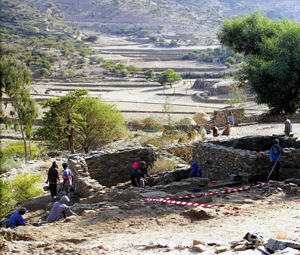The archaeological investigations at Wakarida and in the surrounding area were intended to understand the economic and cultural relationships between the people living in the plateau and those in the African coast of the Red Sea, and with the opposite coast of the Arabian Peninsula, in particular Southern Arabia. Indeed, Wakarida is an outpost on the Danakil to the E, towards the Red Sea (the so-called Salt Plan, where the main activity, practiced since ancient times, is the trade of salt). Unfortunately, no settlements related to the Sabaean culture were identified.
During the archaeological surveys, a number of monuments and settlements, mostly farms, from the Aksumite period were discovered. The excavations in Wakarida brought to light some buildings from the Middle and Late Aksumite period (350/400–800/850 AD); apart from a few imported objects (fragments of amphorae and a Sassanid seal), the architecture and the material culture are absolutely coherent with the capital Aksum and Matara (Eritrea), suggesting a strong cultural unity in the Aksumite Empire.

Countries

